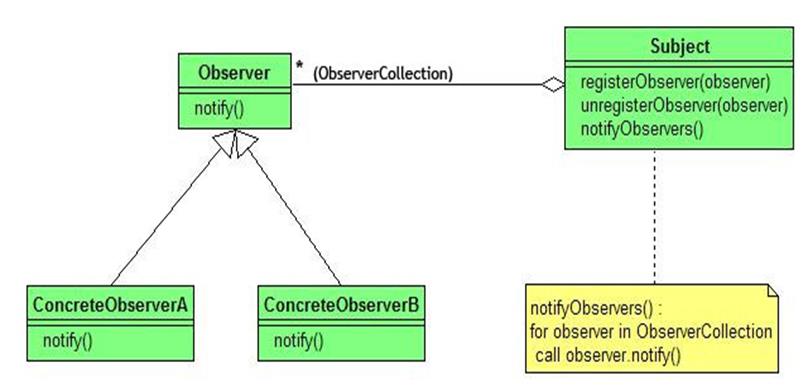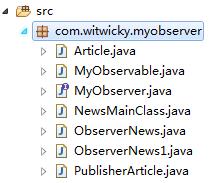观察者模式(Observer)
Posted Archibald Witwicky
tags:
篇首语:本文由小常识网(cha138.com)小编为大家整理,主要介绍了观察者模式(Observer)相关的知识,希望对你有一定的参考价值。
一:基本概念
1.什么是观察者模式
- Observer模式是行为模式之一,它的作用是当一个对象的状态发生变化时,能够自动通知其他关联对象,自动刷新对象状态。
- Observer模式提供给关联对象一种同步通信的手段,使某个对象与依赖它的其他对象之间保持状态同步。
2.观察者模式的UML结构

3.观察者模式的角色和职责
- Subject(被观察者) 被观察的对象。当需要被观察的状态发生变化时,需要通知队列中所有观察者对象。Subject需要维持(添加,删除,通知)一个观察者对象的队列列表。
- ConcreteSubject 被观察者的具体实现。包含一些基本的属性状态及其他操作。
- Observer(观察者) 接口或抽象类。当Subject的状态发生变化时,Observer对象将通过一个callback函数得到通知。
- ConcreteObserver 观察者的具体实现。得到通知后将完成一些具体的业务逻辑处理。
4.观察者模式的典型应用
- Observer模式的典型应用
- 侦听事件驱动程序设计中的外部事件
- 侦听/监视某个对象的状态变化
- 发布者/订阅者(publisher/subscriber)模型中,当一个外部事件(新的产品,消息的出现等等)被触发时,通知邮件列表中的订阅者
二:具体例子
1.功能需求描述:发布一条新闻的时候,观察者可以观察到。
2.具体实现:
2.1.效果:

2.2.项目结构
- Article.java-文章bean
- MyObservable.java-被观察者要实现的基类
- MyObserver.java-观察者要实现的接口
- NewsMainClass.java-启动方法
- ObserverNews.java-实现了观察者接口的类
- ObserverNews1.java-实现了观察者接口的类
- PublisherArticle.java-实现了被观察者的类

2.3.运行流程
2.3.1.NewsMainClass.java类主要将,观察者对象注入到被观察者对象中。
package com.witwicky.myobserver;
public class NewsMainClass {
public static void main(String[] args) {
Article article = new Article("title1", "content1");
PublisherArticle pa = new PublisherArticle();
ObserverNews obn = new ObserverNews();
ObserverNews1 obn1 = new ObserverNews1();
pa.addOberserver(obn);
pa.addOberserver(obn1);
pa.removeOberserver(obn1);
// pa.removeAll(); //可以使用
pa.publisherArt(article);
}
}
2.3.2.Article.java-文章bean
package com.witwicky.myobserver;
public class Article {
private String title;
private String content;
public Article(String title, String content) {
this.title = title;
this.content = content;
}
public String getTitle() {
return title;
}
public void setTitle(String title) {
this.title = title;
}
public String getContent() {
return content;
}
public void setContent(String content) {
this.content = content;
}
@Override
public String toString() {
return "Article [title=" + title + ", content=" + content + "]";
}
}
2.3.3.MyObservable.java-被观察者要实现的基类
自己实现:
package com.witwicky.myobserver;
import java.util.Vector;
public class MyObservable {
private Vector<MyObserver> observerList = new Vector<>();
public void notifyObservers() {
notifyObservers(null);
}
public void notifyObservers(Object object) {
for (MyObserver myObserver : observerList) {
myObserver.update(myObserver, object);
}
}
public void addOberserver(MyObserver observer) {
if(!observerList.contains(observer)) {
observerList.addElement(observer);
}
}
public void removeOberserver(MyObserver observer) {
observerList.remove(observer);
}
public void removeAll() {
observerList.removeAllElements();
}
public Integer obsCount() {
return observerList.size();
}
}
JDK中官方实现:
/*
* Copyright (c) 1994, 2012, Oracle and/or its affiliates. All rights reserved.
* ORACLE PROPRIETARY/CONFIDENTIAL. Use is subject to license terms.
*/
package java.util;
/**
* This class represents an observable object, or "data"
* in the model-view paradigm. It can be subclassed to represent an
* object that the application wants to have observed.
* <p>
* An observable object can have one or more observers. An observer
* may be any object that implements interface <tt>Observer</tt>. After an
* observable instance changes, an application calling the
* <code>Observable</code>\'s <code>notifyObservers</code> method
* causes all of its observers to be notified of the change by a call
* to their <code>update</code> method.
* <p>
* The order in which notifications will be delivered is unspecified.
* The default implementation provided in the Observable class will
* notify Observers in the order in which they registered interest, but
* subclasses may change this order, use no guaranteed order, deliver
* notifications on separate threads, or may guarantee that their
* subclass follows this order, as they choose.
* <p>
* Note that this notification mechanism has nothing to do with threads
* and is completely separate from the <tt>wait</tt> and <tt>notify</tt>
* mechanism of class <tt>Object</tt>.
* <p>
* When an observable object is newly created, its set of observers is
* empty. Two observers are considered the same if and only if the
* <tt>equals</tt> method returns true for them.
*
* @author Chris Warth
* @see java.util.Observable#notifyObservers()
* @see java.util.Observable#notifyObservers(java.lang.Object)
* @see java.util.Observer
* @see java.util.Observer#update(java.util.Observable, java.lang.Object)
* @since JDK1.0
*/
public class Observable {
private boolean changed = false;
private Vector<Observer> obs;
/** Construct an Observable with zero Observers. */
public Observable() {
obs = new Vector<>();
}
/**
* Adds an observer to the set of observers for this object, provided
* that it is not the same as some observer already in the set.
* The order in which notifications will be delivered to multiple
* observers is not specified. See the class comment.
*
* @param o an observer to be added.
* @throws NullPointerException if the parameter o is null.
*/
public synchronized void addObserver(Observer o) {
if (o == null)
throw new NullPointerException();
if (!obs.contains(o)) {
obs.addElement(o);
}
}
/**
* Deletes an observer from the set of observers of this object.
* Passing <CODE>null</CODE> to this method will have no effect.
* @param o the observer to be deleted.
*/
public synchronized void deleteObserver(Observer o) {
obs.removeElement(o);
}
/**
* If this object has changed, as indicated by the
* <code>hasChanged</code> method, then notify all of its observers
* and then call the <code>clearChanged</code> method to
* indicate that this object has no longer changed.
* <p>
* Each observer has its <code>update</code> method called with two
* arguments: this observable object and <code>null</code>. In other
* words, this method is equivalent to:
* <blockquote><tt>
* notifyObservers(null)</tt></blockquote>
*
* @see java.util.Observable#clearChanged()
* @see java.util.Observable#hasChanged()
* @see java.util.Observer#update(java.util.Observable, java.lang.Object)
*/
public void notifyObservers() {
notifyObservers(null);
}
/**
* If this object has changed, as indicated by the
* <code>hasChanged</code> method, then notify all of its observers
* and then call the <code>clearChanged</code> method to indicate
* that this object has no longer changed.
* <p>
* Each observer has its <code>update</code> method called with two
* arguments: this observable object and the <code>arg</code> argument.
*
* @param arg any object.
* @see java.util.Observable#clearChanged()
* @see java.util.Observable#hasChanged()
* @see java.util.Observer#update(java.util.Observable, java.lang.Object)
*/
public void notifyObservers(Object arg) {
/*
* a temporary array buffer, used as a snapshot of the state of
* current Observers.
*/
Object[] arrLocal;
synchronized (this) {
/* We don\'t want the Observer doing callbacks into
* arbitrary code while holding its own Monitor.
* The code where we extract each Observable from
* the Vector and store the state of the Observer
* needs synchronization, but notifying observers
* does not (should not). The worst result of any
* potential race-condition here is that:
* 1) a newly-added Observer will miss a
* notification in progress
* 2) a recently unregistered Observer will be
* wrongly notified when it doesn\'t care
*/
if (!changed)
return;
arrLocal = obs.toArray();
clearChanged();
}
for (int i = arrLocal.length-1; i>=0; i--)
((Observer)arrLocal[i]).update(this, arg);
}
/**
* Clears the observer list so that this object no longer has any observers.
*/
public synchronized void deleteObservers() {
obs.removeAllElements();
}
/**
* Marks this <tt>Observable</tt> object as having been changed; the
* <tt>hasChanged</tt> method will now return <tt>true</tt>.
*/
protected synchronized void setChanged() {
changed = true;
}
/**
* Indicates that this object has no longer changed, or that it has
* already notified all of its observers of its most recent change,
* so that the <tt>hasChanged</tt> method will now return <tt>false</tt>.
* This method is called automatically by the
* <code>notifyObservers</code> methods.
*
* @see java.util.Observable#notifyObservers()
* @see java.util.Observable#notifyObservers(java.lang.Object)
*/
protected synchronized void clearChanged() {
changed = false;
}
/**
* Tests if this object has changed.
*
* @return <code>true</code> if and only if the <code>setChanged</code>
* method has been called more recently than the
* <code>clearChanged</code> method on this object;
* <code>false</code> otherwise.
* @see java.util.Observable#clearChanged()
* @see java.util.Observable#setChanged()
*/
public synchronized boolean hasChanged() {
return changed;
}
/**
* Returns the number of observers of this <tt>Observable</tt> object.
*
* @return the number of observers of this object.
*/
public synchronized int countObservers() {
return obs.size();
}
}
2.3.4.MyObserver.java-观察者要实现的接口
自己实现:
package com.witwicky.myobserver;
public interface MyObserver {
public void update(MyObserver myobserver, Object object);
}
JDK官方实现:
/*
* Copyright (c) 1994, 1998, Oracle and/or its affiliates. All rights reserved.
* ORACLE PROPRIETARY/CONFIDENTIAL. Use is subject to license terms.
*/
package java.util;
/**
* A class can implement the <code>Observer</code> interface when it
* wants to be informed of changes in observable objects.
*
* @author Chris Warth
* @see java.util.Observable
* @since JDK1.0
*/
public interface Observer {
/**
* This method is called whenever the observed object is changed. An
* application calls an <tt>Observable</tt> object\'s
* <code>notifyObservers</code> method to have all the object\'s
* observers notified of the change.
*
* @param o the observable object.
* @param arg an argument passed to the <code>notifyObservers</code>
* method.
*/
void update(Observable o, Object arg);
}
2.3.5.ObserverNews.java-实现了观察者接口的类
package com.witwicky.myobserver;
public class ObserverNews implements MyObserver {
@Override
public void update(MyObserver myobserver, Object object) {
System.out.println("观察者:观察到又发布了一条新闻,内容如下:"+object.toString());
}
}
2.3.6.ObserverNews1.java-实现了观察者接口的类
package com.witwicky.myobserver;
public class ObserverNews1 implements MyObserver {
@Override
public void update(MyObserver myobserver, Object object) {
System.out.println("观察者1:观察到又发布了一条新闻,内容如下:"+object.toString());
}
}
2.3.7.PublisherArticle.java-实现了被观察者的类
package com.witwicky.myobserver;
public class PublisherArticle extends MyObservable {
public void publisherArt(Article article) {
System.out.println("发布者:发布了新文章:" + article.toString());
this.notifyObservers(article);
System.out.println(this.obsCount());
}
}
注:最关键的两个类是 MyObserver与MyObservalbe,自己实现代码更灵活一些,如果只是使用基本功能的话,官方JDK版本,更健壮。
以上是关于观察者模式(Observer)的主要内容,如果未能解决你的问题,请参考以下文章